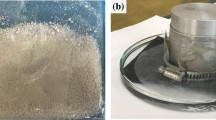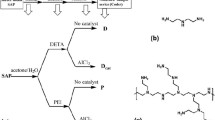Abstract
Surface cross-linking of acrylic-based water absorbent particles was conducted to enhance swollen gel strength. Partially neutralized acrylic acid was synthesized via solution polymerization, and then modification of superabsorbent polymer was imposed on the surface of its particles using bisphenol A diethylene glycidyl ether (BADGE) and 3,4-epoxycyclohexylmethyl-3,4-epoxycyclohexane carboxylate (CAE) resins. The two-step surface treatment was conducted initially, by homogenous soaking in treatment solution containing cross-linker and solvent (90 wt% acetone and 10 wt% deionized water) and then heating at 170 °C, to complete reaction, subsequently. ATR-FTIR spectroscopy, rheometry analysis, swelling capacity measurements in deionized water and saline solution (0.9 wt% NaCl) and swelling kinetics measurments were also employed for accurate investigation. Effect of both epoxy resins content as the effective parameter has been examined. Addition of a little amount of cross-linker raised the storage modulus about 30 % but the higher amounts of the reagents increased it up to 100 %. Both resins could significantly improve the absorbency under load. Heating duration was another effective parameter which has been investigated for BADGE resin. Two different trends have been observed for variant heating intervals. Network structure has been revealed by means of average M c calculating by the modified rubber elasticity theory. Besides, swelling kinetics of BADGE-treated sample was approximated by employing Voigt-based viscoelastic model and its parameters have been derived and compared with diethylene glycol diglycidyl ether-treated sample, as well.








Similar content being viewed by others

References
Buchholz FL, Graham AT (1998) Modern superabsorbent polymer technology. Wiley Sons, New York
Zohuriaan-Mehr MJ, Kabiri K (2008) Superabsorbent polymer materials: a review. Iran Polym J 17:451–477
Zohuriaan-Mehr MJ, Omidian H, Doroudiani S, Kabiri K (2010) Advances in non-hygienic applications of superabsorbent hydrogel materials. J Mater Sci 45:5711–5735
http://www.nonwovens-industry.com/issues/2013-11-01/view_far-east-report/a-look-at-the-top-superabsorbent-polymer-makers-in-the-world/. Accessed 18 July 2014
Christenson EM, Anseth KS, Van den Beucken JJ, Chan CK, Ercan B, Jansen JA, Laurencin CT, Li WJ, Murugan R, Nair LS, Ramakrishna S, Tuan RS, Webster TJ, Mikos AG (2007) Nanobiomaterial applications in orthopedics. J Orthop Res 25:11–22
Myung D, Waters D, Wiscman M, Duhamel PE, Noolandi J, Ta CN, Frank CW (2008) Progress in the development of interpenetrating polymer network hydrogels. Polym Adv Technol 19:647–657
Peak CW, Nagar S, Watts RD, Schmidt G (2014) Robust and degradable hydrogels from poly (ethylene glycol) and semi-interpenetrating collagen. Macromolecules 47:6408–6417
Kheirabadi M, Bagheri R, Kabiri K (2015) Structure, swelling and mechanical behavior of a cationic full-IPN hydrogel reinforced with modified nanoclay. Iran Polym J 24:379–388
Li MC, Ge X, Cho UR (2013) Mechanical performance, water absorption behavior and biodegradability of poly (methyl methacrylate)-modified starch/SBR biocomposites. Macromol Res 21:793–800
Zhu H, Yao X (2013) Synthesis and characterization of poly (acrylamide-co-2-acrylamido-2-methylpropane sulfonic acid)/kaolin superabsorbent composite. J Macromol Sci Pure 50:175–184
Rodrigues FHA, Spagnol C, Pereira AGB, Martins AF, Fajardo AR, Rubira AF, Muniz EC (2014) Superabsorbent hydrogel composites with a focus on hydrogels containing nanofibers or nanowhiskers of cellulose and chitin. J Appl Polym Sci. doi:10.1002/APP.39725
Nogi K, Ishizaki K, Konishi K (2012) Polyacrylic acid (salt)-type water absorbent resin and method for producing of same. US Patent 0157650
Daniel T, Exner KM, Massonne K, Riegel U, Weismantel M (2007) Method for cross-linking hydrogels with morpholine-2,3-diones. US Patent 7183360
Flohr A (2010) Superabsorbent polymers having radiation activatable surface cross-linkers and method of making them. US Patent 7700663
Cipriano BH, Banik SJ, Sharma R, Rumore D, Hwang W, Briber RM, Raghavan SR (2014) Superabsorbent hydrogels that are robust and highly stretchable. Macromolecules 47:4445–4452
Ramazani-Harandi MJ, Zohuriaan-Mehr MJ, Yousefi AA, Ershad-Langroudi A, Kabiri K (2009) Effects of structural variables on AUL and rheological behavior of SAP gels. J Appl Polym Sci 113:3676–3686
Jockusch S, Turro NJ, Mitsukami Y, Matsumoto M, Iwamura T, Lindner T, Flohr A, di Massimo G (2009) Photoinduced surface cross-linking of superabsorbent polymer particles. J Appl Polym Sci 111:2163–2170
Thote AJ, Chappell JT Jr, Gupta RB, Kumar R (2005) Reduction in the initial-burst release by surface crosslink-king of PLGA microparticles containing hydrophilic or hydrophobic drugs. Drug Dev Ind Pharm 31:43–57
Huang X, Chestang BL, Brazel CS (2002) Minimization of initial burst in poly (vinyl alcohol) hydrogels by surface extraction and surface-preferential cross-linking. Int J Pharm 248:183–192
Ma S, Liu M, Chen Z (2004) Preparation and properties of a salt-resistant superabsorbent polymer. J Appl Polym Sci 93:2532–2541
Huang J, Huang ZM, Bao YZ, Weng ZX (2006) Synthesis and characterization of reinforced acrylic-based superabsorbents cross-linked with divinylbenzene. J Appl Polym Sci 100:1594–1600
Mudiyanselage TK, Neckers DC (2008) Highly absorbing superabsorbent polymer. J Appl Polym Sci 46:1357–1364
Wicks ZW, Jones FN, Pappas SP (1999) Organic coating science and technology, 2nd edn. Wiley, New York 11
Wu S, Soucek MD (2000) Cross-linking of acrylic latex coatings with cycloaliphatic diepoxide. Polymer 41:2017–2028
Shechter L, Wynstra J (1956) Glycidyl ether reactions with alcohols, phenols, carboxylic acids, and acid anhydrides. Ind Eng Chem 48:86–93
Wu S, Jorgensen JD, Soucek MD (2000) Synthesis of model acrylic latexes for cross-linking with cycloaliphatic diepoxides. Polymer 41:81–92
Teng G, Soucek MD (2001) Synthesis and characterization of cycloaliphatic diepoxide cross-linkable core-shell latexes. Polymer 42:2849–2862
Kabiri K, Hesarian S, Jamshidi A, Zohuriaan-Mehr MJ, Boohendi H, Poorheravi MR, Hashemi SA, Ahmad-Khanbeigi F (2011) Minimization of residual monomer content of superabsorbent hydrogels via alteration of initiating system. J Appl Polym Sci 120:2716–2723
Merfeld G, Molaison C, Koeniger R, Acar AE, Mordhorst S, Suriano J, Irwin P, Warner RS, Gray K, Smith M, Kovaleski K, Garrett G, Finley S, Meredith D, Spicer M, Naguy T (2005) Acid/epoxy reaction catalyst screening for low temperature (120 ◦C) powder coatings. Prog Org Coat 52:98–109
Nikolic G, Zlatkovic S, Cakic M, Cakic S, Lacnjevac C, Rajic Z (2010) Fast fourier transform IR characterization of epoxy GY systems cross-linked with aliphatic and cycloaliphatic EH polyamine adducts. Sensors 10:684–696
Dong J, Ozaki Y, Nakashima K (1997) Infrared, Raman, and near-infrared spectroscopic evidence for the coexistence of various hydrogen-bond forms in poly(acrylic acid). Macromolecules 30:1111–1117
Goswami TH, Nandan B, Alam S, Mathur GN (2003) A selective reaction of polyhydroxy fullerene with cycloaliphatic epoxy resin in designing ether connected epoxy star utilizing fullerene as a molecular core. Polymer 44:3209–3214
Pavia DL, Lampman GM, Kriz JS (1979) Introduction to spectroscopy: a guide for students of organic chemistry. WB Saunders Co., Philadelphia
Nielsen LE, Landel RF (1994) Mechanical properties of polymers and composites, vol 2. Marcel Dekker Inc, New York
Gundogan N, Melekaslan D, Okay O (2002) Rubber elasticity of poly (N-isopropylacrylamide) gels at various charge densities. Macromolecules 35:5616–5622
Es-haghi H, Bouhendi H, Bagheri-Marandi GH, Zohurian-Mehr MJ, Kabiri K (2012) Rheological properties of microgel prepared with long-chain crosslinkers by a precipitation polymerization method. J Macromol Sci Phys 51:880–896
Yazici I, Okay O (2005) Spatial inhomogeneity in poly (acrylic acid) hydrogels. Polymer 46:2595–2602
Chen J, Shen J (2000) Swelling behaviors of polyacrylate superabsorbent in the mixtures of water and hydrophilic solvents. J Appl Polym Sci 75:1331–1338
Amsden B (1998) Solute diffusion within hydrogels. Mechanisms and models. Macromolecules 31:8382–8395
Okay O, Duramz S (2002) Charge density dependence of elastic modulus of strong polyelectrolyte hydrogels. Polymer 43:1215–1221
Zeldovich KB, Khokhlov AR (1999) Osmotically active and passive counterions in inhomogeneous polymer gels. Macromolecules 32:3488–3494
Dobrynin AV, Colby RH, Rubinstein M (1995) Scaling theory of polyelectrolyte solutions. Macromolecules 28:1859–1871
Omidian H, Hashemi SA, Sammes PG, Meldrum I (1998) A model for the swelling of superabsorbent polymers. Polymer 39:6697–6704
Author information
Authors and Affiliations
Corresponding author
Rights and permissions
About this article
Cite this article
Moini, N., Kabiri, K. Effective parameters in surface cross-linking of acrylic-based water absorbent polymer particles using bisphenol A diethylene glycidyl ether and cycloaliphatic diepoxide. Iran Polym J 24, 977–987 (2015). https://doi.org/10.1007/s13726-015-0386-4
Received:
Accepted:
Published:
Issue Date:
DOI: https://doi.org/10.1007/s13726-015-0386-4



